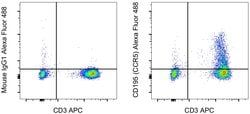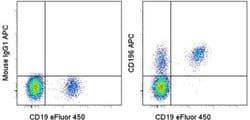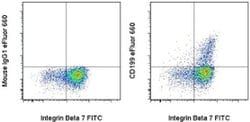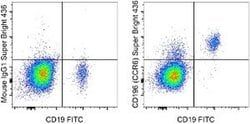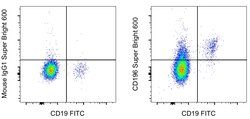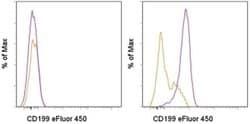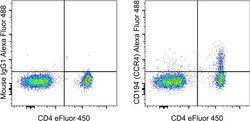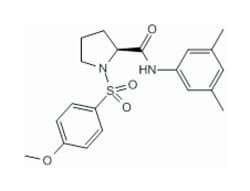53-194-942
CD194 (CCR4) Monoclonal Antibody (D8SEE), Alexa Fluor™ 488, eBioscience™, Invitrogen™
Manufacturer: Invitrogen
Select a Size
| Pack Size | SKU | Availability | Price |
|---|---|---|---|
| Each of 1 | 53-194-942-Each-of-1 | In Stock | ₹ 32,485.00 |
53-194-942 - Each of 1
In Stock
Quantity
1
Base Price: ₹ 32,485.00
GST (18%): ₹ 5,847.30
Total Price: ₹ 38,332.30
Antigen
CD194 (CCR4)
Classification
Monoclonal
Concentration
5 μL/Test
Formulation
PBS with 0.2% BSA and 0.09% sodium azide; pH 7.2
Gene Accession No.
P51679
Gene Symbols
Ccr4
Purification Method
Affinity chromatography
Regulatory Status
RUO
Gene ID (Entrez)
1233
Content And Storage
4° C, store in dark, DO NOT FREEZE!
Form
Liquid
Applications
Flow Cytometry
Clone
D8SEE
Conjugate
Alexa Fluor 488
Gene
Ccr4
Gene Alias
C-C chemokine receptor 4; C-C chemokine receptor type 4; C-C CKR-4; C-C motif chemokine receptor 4; CC-CKR-4; Ccr4; CCR-4; CD194; chemokine (C-C motif) receptor 4; chemokine (C-C) receptor 4; CHEMR1; ChemR13; CKR4; Cmkbr4; fusin; HGCN:14099; K5-5; LESTR; leukocyte-expressed seven-transmembrane-domain receptor; MGC88293; Sdf1r
Host Species
Mouse
Quantity
100 Tests
Primary or Secondary
Primary
Target Species
Human
Product Type
Antibody
Isotype
IgG1 κ
Description
- Description: This D8SEE monoclonal antibody reacts with human CD194 (CCR4)
- CD194, also known as C-C Chemokine Receptor 4 (CCR4) is a member of the G protein-coupled receptor family, a large family characterized by seven transmembrane alpha helical domains
- The ligands for CCR4 are CCL17 (TARC) and CCL22 (MDC), which direct the migration of target cells
- CCR4 and its ligands, along with the other receptors CCR10 and CLA, are particularly important for the recruitment of T cells into the skin, where they may also play a role in adhesion and extravasation
- Although CCR4 expression was originally believed to be restricted to Th2 cells, it has since been observed in some subsets of Th17, Treg, and Th1 cells
- It is not expressed by naive T cells, indicating a role in memory or effector function
- Other cells that express CCR4 are activated NK cells, platelets, monocytes, and basophils
- Applications Reported: This D8SEE antibody has been reported for use in flow cytometric analysis
- Applications Tested: This D8SEE antibody has been pre-titrated and tested by flow cytometric anaylis of normal human peripheral blood cells
- This can be used at 5 μL (0.125 μg) per test
- A test is defined as the amount (μg) of antibody that will stain a cell sample in a final volume of 100 μL
- Cell number should be determined empirically but can range from 10^5 to 10^8 cells/test
- Excitation: 488 nm; Emission: 519 nm; Laser: Blue Laser CCR4 is a chemokine receptor and is preferentially expressed on type 2 helper T (Th2-type) cells
- In contrast to other chemokine receptors, the expression of CCR4 and CCR8 on Th2 cells is transiently increased following TCR and CD28 engagement
- Moreover, activated Th1 cells up-regulate CCR4 expression and functional responsiveness to thymus- and activation-regulated chemokine
- Chemokines are a group of small (approximately 8 to 14 kD), mostly basic, structurally related molecules that regulate cell trafficking of various types of leukocytes through interactions with a subset of 7-transmembrane, G protein-coupled receptors
- Chemokines also play fundamental roles in the development, homeostasis, and function of the immune system, and they have effects on cells of the central nervous system as well as on endothelial cells involved in angiogenesis or angiostasis
- Chemokines are divided into 2 major subfamilies, CXC and CC, based on the arrangement of the first 2 of the 4 conserved cysteine residues; the 2 cysteines are separated by a single amino acid in CXC chemokines and are adjacent in CC chemokines.
Compare Similar Items
Show Difference
Antigen: CD194 (CCR4)
Classification: Monoclonal
Concentration: 5 μL/Test
Formulation: PBS with 0.2% BSA and 0.09% sodium azide; pH 7.2
Gene Accession No.: P51679
Gene Symbols: Ccr4
Purification Method: Affinity chromatography
Regulatory Status: RUO
Gene ID (Entrez): 1233
Content And Storage: 4° C, store in dark, DO NOT FREEZE!
Form: Liquid
Applications: Flow Cytometry
Clone: D8SEE
Conjugate: Alexa Fluor 488
Gene: Ccr4
Gene Alias: C-C chemokine receptor 4; C-C chemokine receptor type 4; C-C CKR-4; C-C motif chemokine receptor 4; CC-CKR-4; Ccr4; CCR-4; CD194; chemokine (C-C motif) receptor 4; chemokine (C-C) receptor 4; CHEMR1; ChemR13; CKR4; Cmkbr4; fusin; HGCN:14099; K5-5; LESTR; leukocyte-expressed seven-transmembrane-domain receptor; MGC88293; Sdf1r
Host Species: Mouse
Quantity: 100 Tests
Primary or Secondary: Primary
Target Species: Human
Product Type: Antibody
Isotype: IgG1 κ
Antigen:
CD194 (CCR4)
Classification:
Monoclonal
Concentration:
5 μL/Test
Formulation:
PBS with 0.2% BSA and 0.09% sodium azide; pH 7.2
Gene Accession No.:
P51679
Gene Symbols:
Ccr4
Purification Method:
Affinity chromatography
Regulatory Status:
RUO
Gene ID (Entrez):
1233
Content And Storage:
4° C, store in dark, DO NOT FREEZE!
Form:
Liquid
Applications:
Flow Cytometry
Clone:
D8SEE
Conjugate:
Alexa Fluor 488
Gene:
Ccr4
Gene Alias:
C-C chemokine receptor 4; C-C chemokine receptor type 4; C-C CKR-4; C-C motif chemokine receptor 4; CC-CKR-4; Ccr4; CCR-4; CD194; chemokine (C-C motif) receptor 4; chemokine (C-C) receptor 4; CHEMR1; ChemR13; CKR4; Cmkbr4; fusin; HGCN:14099; K5-5; LESTR; leukocyte-expressed seven-transmembrane-domain receptor; MGC88293; Sdf1r
Host Species:
Mouse
Quantity:
100 Tests
Primary or Secondary:
Primary
Target Species:
Human
Product Type:
Antibody
Isotype:
IgG1 κ
Antigen: __
Classification: __
Concentration: __
Formulation: __
Gene Accession No.: __
Gene Symbols: __
Purification Method: __
Regulatory Status: __
Gene ID (Entrez): __
Content And Storage: __
Form: __
Applications: __
Clone: __
Conjugate: __
Gene: __
Gene Alias: __
Host Species: __
Quantity: 50 mg
Primary or Secondary: __
Target Species: __
Product Type: ACT 462206
Isotype: __
Antigen:
__
Classification:
__
Concentration:
__
Formulation:
__
Gene Accession No.:
__
Gene Symbols:
__
Purification Method:
__
Regulatory Status:
__
Gene ID (Entrez):
__
Content And Storage:
__
Form:
__
Applications:
__
Clone:
__
Conjugate:
__
Gene:
__
Gene Alias:
__
Host Species:
__
Quantity:
50 mg
Primary or Secondary:
__
Target Species:
__
Product Type:
ACT 462206
Isotype:
__
Antigen: CD195 (CCR5)
Classification: Monoclonal
Concentration: 5 μL/Test
Formulation: PBS with 0.2% BSA and 0.09% sodium azide; pH 7.2
Gene Accession No.: P51681
Gene Symbols: CCR5
Purification Method: Affinity chromatography
Regulatory Status: RUO
Gene ID (Entrez): 1234
Content And Storage: 4° C, store in dark, DO NOT FREEZE!
Form: Liquid
Applications: Flow Cytometry
Clone: NP-6G4
Conjugate: Alexa Fluor 488
Gene: CCR5
Gene Alias: AM4-7; C-C chemokine receptor type 5; C-C CKR-5; C-C motif chemokine receptor 5 (gene/pseudogene); C-C motif chemokine receptor 5 A159A; CCCKR5; CC-CKR-5; Ccr5; CCR-5; CD195; CD195 antigen; chemokine (C-C motif) receptor 5; chemokine (C-C) receptor 5; chemokine receptor CCR5; chemr13; CKR5; CKR-5; Cmkbr5; HIV-1 fusion coreceptor; IDDM22; MIP-1 alpha receptor
Host Species: Mouse
Quantity: 100 Tests
Primary or Secondary: Primary
Target Species: Human
Product Type: Antibody
Isotype: IgG1 κ
Antigen:
CD195 (CCR5)
Classification:
Monoclonal
Concentration:
5 μL/Test
Formulation:
PBS with 0.2% BSA and 0.09% sodium azide; pH 7.2
Gene Accession No.:
P51681
Gene Symbols:
CCR5
Purification Method:
Affinity chromatography
Regulatory Status:
RUO
Gene ID (Entrez):
1234
Content And Storage:
4° C, store in dark, DO NOT FREEZE!
Form:
Liquid
Applications:
Flow Cytometry
Clone:
NP-6G4
Conjugate:
Alexa Fluor 488
Gene:
CCR5
Gene Alias:
AM4-7; C-C chemokine receptor type 5; C-C CKR-5; C-C motif chemokine receptor 5 (gene/pseudogene); C-C motif chemokine receptor 5 A159A; CCCKR5; CC-CKR-5; Ccr5; CCR-5; CD195; CD195 antigen; chemokine (C-C motif) receptor 5; chemokine (C-C) receptor 5; chemokine receptor CCR5; chemr13; CKR5; CKR-5; Cmkbr5; HIV-1 fusion coreceptor; IDDM22; MIP-1 alpha receptor
Host Species:
Mouse
Quantity:
100 Tests
Primary or Secondary:
Primary
Target Species:
Human
Product Type:
Antibody
Isotype:
IgG1 κ
Antigen: CD200R3
Classification: Monoclonal
Concentration: 0.5 mg/mL
Formulation: PBS with 0.09% sodium azide; pH 7.2
Gene Accession No.: Q5UKY4
Gene Symbols: CD200R3
Purification Method: Affinity chromatography
Regulatory Status: RUO
Gene ID (Entrez): 74603
Content And Storage: 4° C, store in dark, DO NOT FREEZE!
Form: Liquid
Applications: Flow Cytometry
Clone: Ba13
Conjugate: Alexa Fluor 488
Gene: CD200R3
Gene Alias: 4733401I18Rik; 4833409J19Rik; AI505817; BB106877; CD200 cell surface glycoprotein receptor 3; CD200 cell surface glycoprotein receptor-like 3; CD200 cell surface glycoprotein receptor-like b; CD200 receptor 3; CD200 receptor-like 3; Cd200r3; CD200RLb; cell surface glycoprotein CD200 receptor 3; Cell surface glycoprotein OX2 receptor 3; mCD200RLb
Host Species: Rat
Quantity: 100 μg
Primary or Secondary: Primary
Target Species: Mouse
Product Type: Antibody
Isotype: IgG2a κ
Antigen:
CD200R3
Classification:
Monoclonal
Concentration:
0.5 mg/mL
Formulation:
PBS with 0.09% sodium azide; pH 7.2
Gene Accession No.:
Q5UKY4
Gene Symbols:
CD200R3
Purification Method:
Affinity chromatography
Regulatory Status:
RUO
Gene ID (Entrez):
74603
Content And Storage:
4° C, store in dark, DO NOT FREEZE!
Form:
Liquid
Applications:
Flow Cytometry
Clone:
Ba13
Conjugate:
Alexa Fluor 488
Gene:
CD200R3
Gene Alias:
4733401I18Rik; 4833409J19Rik; AI505817; BB106877; CD200 cell surface glycoprotein receptor 3; CD200 cell surface glycoprotein receptor-like 3; CD200 cell surface glycoprotein receptor-like b; CD200 receptor 3; CD200 receptor-like 3; Cd200r3; CD200RLb; cell surface glycoprotein CD200 receptor 3; Cell surface glycoprotein OX2 receptor 3; mCD200RLb
Host Species:
Rat
Quantity:
100 μg
Primary or Secondary:
Primary
Target Species:
Mouse
Product Type:
Antibody
Isotype:
IgG2a κ
